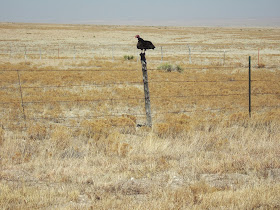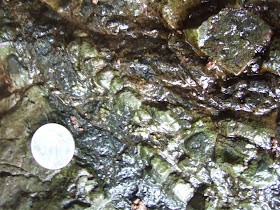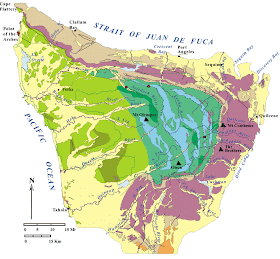I will add there is some interest in this event as it is not a common thing to have the flow in a river shut off even for a short while. On the good news side, the river riparian area is wide enough that though the slide temporarily blocked flow and diverted the river, the blockage and diversion did not threaten any homes or infrastructure.
First a little background as to location and river dynamics.
Aerial view (USGS, 2009)
River is flowing from the right to the left (east to west)
Topographic Map (USGS)
The slope where the landslide took place is marked and is approximately 120 feet high
The Nooksack River Reach between Deming and the highway bridge has been and is rather dynamic with significant channel migration. The dynamic nature of the river continues further to the west as well. During big floods in 1990 on this river reach, the river channel shifted as much as 1,000 feet near Deming in a single flood event and the river took out the State Highway bridge.
But even without major floods the Nooksack near the Clay Banks where the slide took place has done a lot of shifting over the past 15 years. That channel migration is illustrated with the following Google Earth images.
1998 with future landslide marked and channel marked with green line (click on picture to enlarge and better see the line)
In 1998 the river was hard up against a rock rip rap levee on the north side of the river. That rock lined levee prevented the river channel from migrating northward and turned the river back to the south towards the Clay Banks west of the most recent landslide. The levee was constructed in the mid 1990s. By 1998 landslides had begun on the Clay Banks as the river was flowing hard against the base of the slope at that time.
2005
By 2005 the river channel in the vicinity had shifted significantly and was no longer flowing along the levee to the north. Note the wide swath of trees that had been located between the future landslide site and the river in 1998 had been nearly all removed.
2006
Even in one year between 2005 and 2006 the river had shifted and significant land sliding had taken place at the Clay Banks and was beginning to threaten a home that had originally been located 300 feet from the edge of the slope.
2011
By 2011 the river channel shifts are such that the river is flowing at a right angle into the location of the future landslide. By this time the area of landslides to the west was beginning to become vegetated with red alder, but alas the home had fallen down onto the slope.
Oblique aerial view of landslide area (2009)
At the time of the oblique image the lower part of the slope was clearly being eroded and was steep, but the upper slope was still tree covered. The older landslides were still recently active downstream.
Images and notes from my February 22, 2014 visit.
View of the Clay Banks from the northeast
Older slide area with home collapsed onto the slide
Most recent slide area and river blocking slide
Note large blocks of clay on landslide deposit
Very narrow new channel in front of landslide deposit.
I estimated the channel as being 50 feet wide. In contrast to the width elsewhere I took this picture of the river upstream of the site.
Much wider river channel upstream
There is a bit of a pool of slow water above the constriction caused by the landslide deposit.
The above image also shows some of the geologic structure relevant to the landslides. The slide that blocked the river came from the upper bluff. This upper bluff section is glacial drift. A sand layer is below the glacial drift and seeps of water can be seen flowing across the lower bluff. The lower bluff is also glacial drift. Easterbrook (1960s) has interpreted these units from top to bottom as Bellingham glacial marine drift, Deming sand and Kulshan glacial marine drift. I've never been able to take a really good look at these units at this location. Given the much improved exposures it may be a worthwhile exploration for interpreting the late glacial history of the area.
Large blocks of clay from the slope failure
Note this block of clay is on my side of the river across from the landslide
I made a few notes of where blocks of glacial drift were located across the river from the main landslide deposit. The furthest I observed were 150 feet from the new main channel.
Closer view of glacial marine drift block
Classic pebble of diorite pebble embedded within the clay matrix
The clay was soft indicative but not entirely definitive of glacial marine drift versus till as till is more typically hard due to compaction by ice.
The most distal clay blocks I observed
One noteworthy feature was the broad swath of wood deposited upstream of the slide area. Perhaps not unusual along the river, but I saw no similar swaths of wood in any of the aerial images including the high resolution oblique images of the river (see aerials above). What I suspect is that as the water backed up across the riparian area immediately after the flow was temporarily blocked and wood over a relative large area was floated and then grounded as the water began to surge across the wide shallow area to the north of the slide blockage. There were indications of very recent sheet flow across all the area downstream of the wood covered area.
Swath of wood accumulated along the head of the overflow path above the slide blockage
Bent over grasses with cobble deposition over the grass in upper left.
Water would have flowed over a broad swath as a sheet prior to the new channel being cut downward just beyond the main landslide deposition area
More of the sheet flow area and a pre existing small side channel
There is a deer standing in the water in the center of the image.
The deer had come running out of the woods and down the side channel straight toward me. Something was back in the woods it was keen on getting away from.


















































